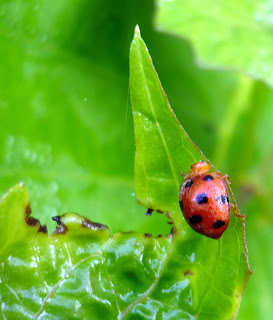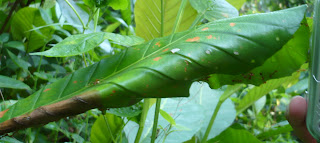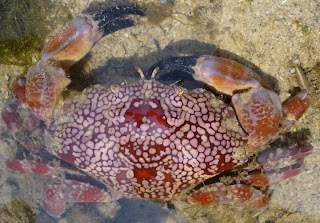Oh dear, looks like i'm the last person to blog about the public walk we had yesterday.
Anyway, this was my first official time being a lead guide (assigned to the group: Mudskippers). Joining the group was five members of the public and five girls from St. Nicholas. Also not forgetting Siyang, who was on OJT, was assigned to be my 'lovely' assistant. =)
Arriving at a early timing at Semakau do has its advantages and disadvantages.
The disadvantage was that the NEA staff had not reached the island yet, so we had to forgo the four wheeler transport and depended on our very own two legged, self-powered 'transport'.
The advantage was that everyone gets enjoy the wind and take in the sights around the island. Here's some 'mudskippers' along the walk (picture below).
 After walking through the forest trail, we reached the shores and immediately headed out to the inter-tidal zone and for the first 'discovery' we have a flat worm (picture below).
After walking through the forest trail, we reached the shores and immediately headed out to the inter-tidal zone and for the first 'discovery' we have a flat worm (picture below). Discovery Note:
Discovery Note:1. Flatworms are hermaphroditic which means they have both the male and female reproductive organs.
2. Their bodies have only a single opening, which serves as both a mouth and an anus.
3. They do not have eyes but has a cluster or clusters of light-sensitive cells make up which are called eyespot/s.
And just next to the flatworm, our keen-eyed hunter seekers had found a sandfish sea cucumber (picture below). Second 'discovery' of the day.
 Discovery Note:
Discovery Note:1. Being related to the sea stars, sea cucumbers have a soft, wormlike body and range from a few centimeters to 90 centimeters in length.
2. Unlike the sea star, however, they have no arms but use a cluster of tube-like feet around their mouth to gather food.
3. To repel predators or when stressed, a sea cucumber might expel their innards or ‘vomit’. And if too much of their innards are expelled, they might die off as a result.
4. The sandfish sea cucumber is the species of sea cucumber which people consume. But they contain toxins, so it must be properly prepared before consumption.
Third 'discovery' was a pair of hairy crabs was spotted (picture below). I wonder if they are a couple. =p. anyway,
 Discovery Note:
Discovery Note:1. The hairs of the hairy crab traps sediment so it blends 'almost' perfectly with its surroundings.
2. We also call this crab the ‘teddy bear crab’. =)
3. The hairy crab eats seaweeds and poisonous zoanthids, which makes the crab mildly poisonous too!
Given that the tide was coming in, i decided to forgo some finds that our hunter seekers have found near the seagrass lagoon and headed out towards the coral rubble area. I thought maybe we could look at those when we were on the way back but then... (read on to find out why)
What awaited us at the coral rubble area was of course loads of corals. Here's one of the leathery soft corals (picture below). Fourth 'discovery'~
 Discovery Note:
Discovery Note:1. Leathery soft corals are made up of a colony of animals.
2. These animals are called polyp. They look like a very tiny sea anemone with a long body topped with tentacles.
Another interesting animal usually found around the coral rubble area are nudibranches. Fifth 'discovery' was one species, the bohol nudibranch (picture below)
 Discovery Note:
Discovery Note:1. 'Nudibranch' means 'naked gills'. The name comes from the flower-like gills found on the back of many nudibranchs. These nudibranchs use the gills to breathe.
2. Nudibranchs are related to snails. Little baby nudibranchs are born with shells, but they lose them when they become adults.
3. Most nudibranchs are carnivores, they eat immobile or small, slow-moving prey. Examples are sponges, ascidians, hard corals, soft corals, sea anemones etc.
Sixth 'discovery' was something i've seen for the first time at Semakau, a spider crab (picture below)!
 Discovery Note:
Discovery Note:1. Spider crabs, which have thick, rather rounded bodies and long, spindly legs, are generally slow-moving and sluggish.
2. Harmless to humans and not particularly aggressive in general, the spider crab's main defence against predators is camouflage: the hook-like hairs on the crab's shell (carapace) hold algae and other small debris in place.
3. Most spider crabs are known to be scavengers.
And here's the iconic star of Semakau, the knobbly sea star (picture below). Seventh 'discovery'.
 Discovery Note:
Discovery Note:1. Can you believe that this is larger than your face? It’s about 30cm across!
2. They get their name from the knobs they have.
3. Although most of them are mostly red or orange in colour, beige or brown coloured knobbly sea stars have been spotted before also.
But where was the 'traditional' group photo with the sea star? Alas, it wasn't possible due to the rain that immediately hit us after i've taken some shots for my group members with the knobbly.
Although the walk was then aborted and everyone had to clear the inter-tidal area due to lighting warning, spirits remained high.
Sidenote:
I couldn't really document that as my camera was not waterproof. But you may read other blogs to find out other sights and happenings on the same day.
1. The tidechaser (Ron's camera was waterproof and managed to capture some of the enjoyment under the rain)
2. Manta's blog (He spotted a clownfish in Semakau!)
3. Siyang's Urban forest (look out for a picture of another kind of sea cucumber)
4. Mountain and Sea blog (TC's camera was also waterproof and he has some other interesting things which i didn't saw)
5. Juan's blog (she had the most 'advanced' waterproof equipment amongst all and she has a video on the Spider Conch!)
Pretty short entry this time round, but nevertheless i guessed most of us enjoyed the day due to the rain. Would like to thank all 'mudskippers' (too bad this time i couldn't get a whole group photo but i do hope you have a memorable morning). And also Siyang for being such a great 'lovely' assistant! =p
Lastly i hope it would be a Sunny Semakau, the next we come back. =)














































